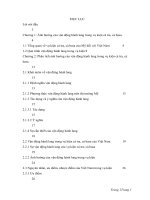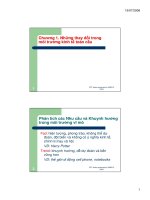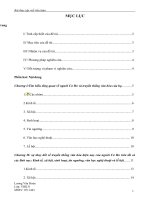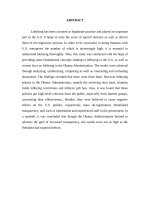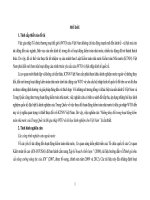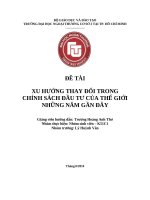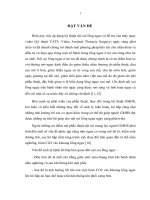NHỮNG THAY đổi TRONG CHÍNH SÁCH vận ĐỘNG HÀNH LANG dưới CHÍNH QUYỀN OBAMA và PHẢN ỨNG của dư LUẬN
Bạn đang xem bản rút gọn của tài liệu. Xem và tải ngay bản đầy đủ của tài liệu tại đây (2.58 MB, 84 trang )
ABSTRACT
Lobbying has been accepted as legitimate practice and played an important
part in the U.S. It helps to raise the voice of special interests as well as inform
them of the legislative process. In order to be successful in doing business with
U.S. enterprises the number of which is increasingly high, it is essential to
understand lobbying thoroughly. Thus, this study was conducted with the hope of
providing some fundamental concepts relating to lobbying in the U.S. as well as
current laws on lobbying in the Obama Administration. The results were achieved
through analyzing, synthesizing, comparing as well as contrasting and evaluating
documents. The findings revealed that there were three basic first-ever lobbying
polices in the Obama Administration, namely the revolving door bans, stimulus
funds lobbying restrictions and lobbyist gift ban. Also, it was found that those
policies got high-level criticism from the public, especially from interest groups,
concerning their effectiveness,. Besides, they were believed to cause negative
effects on the U.S. politics, respectively mass de-registration, diminished
transparency, and, lack of information and experienced staff in the government. In
a nutshell, it was concluded that though the Obama Administration desired to
advance the goal of increased transparency, the results were not as high as the
President had expected before.
TABLE OF CONTENTS
CONTENT
PAGE
Acknowledgements………………………………………………………………….
i
Abstract
………………………………………………………………………………. ii
List of tables, figures and
abbreviations……………………………………………… vi
CHAPTER 1: INTRODUCTION
1.1Statement of the problem and the rationale for the
study……………………… 1
1.2 Aims and objectives of the study
……………………………………………… 2
1.3 Scope of the study
…………………………………………………………… 3
1.4 Significance of the study
……………………………………………………… 3
1.5 Methodology of the
study………………………………………………………… 4
1.6 Organization of the study
………………………………………………………… 4
CHAPTER 2: BACKGROUND AND BASIC CONCEPTS
2.1 Lobbying
2.1.1 Definitions of lobbying
…………………………………………………… 5
2.1.2 Process of lobbying
………………………………………………………… 8
2.2 Lobbyist
2.2.1 Definitions of lobbyist
……………………………………………………… 9
2.2.2 Types of lobbyist
……………………………………………………… 10
2.3 Revolving door
…………………………………………………………… 12
CHAPTER 3: LAWS RELATED TO LOBBYING IN THE PREVIOUS
ADMINISTRATIONS
3.1 The Foreign Agents Registration Act of 1938
…………………………… 15
3.2 The Federal Regulation of Lobbying Act of 1946
………………………… 18
3.3 The Byrd Amendment and Miscellaneous Disclosure Laws of 1989
……… 21
3.4 The Lobbying Disclosure Act of 1995
………………………………… 22
3.5 The Honest Leadership and Open Government Act of 2007
………………… 25
CHAPTER 4: LOBBYING IN THE OBAMA ADMINISTRATION
4.1 Policy changes
……………………………………………………… 27
4.1.1 Revolving door bans
……………………………………………… 28
4.1.2 Restrictions on contacts between lobbyists and executive branch
officials 30
4.1.3 Lobbyist gift bans
……………………………………… 33
4.2 Public responses to changes
4.2.1 Responses to the revolving door bans
……………………………… 35
4.2.2 Responses to stimulus fund lobbying restrictions
……………………… 38
4.2.3 Responses to lobbyist gift bans
…………………………………… 40
4.2.4 Effects
…………………………………………………………… .43
CHAPTER 5: CONCLUSSION
5.1 Summary of main findings
5.1.1 Changes
……………………………………………………………… 46
5.1.2 Responses to changes
………………………………………………… 47
5.2 Limitations of the study
…………………………………………………… 48
5.3 Suggestions for further study
…………………………………………… 48
REFERENCES
APPENDICES
LIST OF TABLES, FIGURES AND ABBREVIATIONS
List of tables
Table 1: Different definitions of lobbying
Table 2: Timeliness of quarterly reports filed for 1989
Table 3: Incomplete Responses in Quarterly Reports for 1989
List of figures
Figure 1: Simplified diagram for lobbying process
Figure 2: New registrations and terminations during calendar years 1960-1972
and active registrations at the end of calendar years 1960-1972
Figure 3: Registrants, Clients and Lobbyists Registered Under the Lobbying
Disclosure Act of 1995, 1996-2004
Figure 4: Number of unique, registered and active lobbyists
List of abbreviations
OGE: Office of Government Ethics
OBM: Office of Budget and Management
ALL: American League of Lobbyists
LDA: The Lobbying Disclosure Act of 1995
FARA: The Foreign Agents Registration Act of 1938
FLRA: The Federal Regulation of Lobbying Act of 1946
HLOGA: The Honest Leadership and Open Government Act of 2007
GAO: The United States General Accounting Office
CHAPTER 1: INTRODUCTION
1.1 Statement of the problem and the rationale for the study
It can be said that lobbying is one of the most typical characteristics of
American politics. It has been a legal practice since it was acknowledged by the
Constitution. The right of people to lobby is protected by the First Amendment:
Congress shall make no law […] abridging the freedom of speech […] or
the right of the people peaceably […] to petition the government for a
redress of grievances.
Madison, J. (n.d.)
Lobbying began to be used intensely in the U.S between 1869 and 1877.
With such a long history, it has increasingly played a fundamental part in
enhancing American democracy. Claimed by Biggs & Helms (2006), lobbying is
“an inextricable part of policy production process” (p.113). In other words,
lobbying plays an indispensable role in the U.S. politics.
After Vietnam joined WTO in 2006, the number of U.S. partners has
increased greatly. One of the most important things to do business successfully
with them is having a thorough understanding of lobbying – a legal practice which
plays a crucial role in influencing government policies to support the interests of
companies. Despite such great influence and significance, lobbying is little known
to Vietnamese people. In Vietnam, there are no laws concerning lobbying; thus,
lobbying activities are “not officially recognized” (cited in Trung Kien, 2007).
Moreover, lobbying in Vietnam is often bound with negative meanings and
misunderstood. People usually think about “bribery” or “to get in by the back
door” when mentioning lobbying (cited in Doan Trang, 2010). In this situation,
there is a need to give a clear and precise definition of lobbying to replace those
misperceptions.
Furthermore, there are a number of new rules and regulations in lobbying
policies addressed by the incumbent President Barack Obama that Vietnamese
enterprises need to know and understand. Therefore, it is necessary to do research
on lobbying in the U.S to help Vietnamese companies get fundamentals as well as
current laws on lobbying.
At the Faculty of English Language Teacher - University of Languages and
International Study (FELTE – ULIS), American Studies has been included in the
syllabus recently to provide the English majors background knowledge, so that
they could work with the U.S. partners in the future. Therefore, understanding
American politics and society, including lobbying, is very important not only for
their study but for their future jobs. Yet most of them lack basic knowledge about
lobbying which is a key factor of U.S. business. According to a survey by Phung
(2009), 80% of the students do not understand exactly what the aims of lobbying
activities are while 36% think that lobbying activities are connected to corruption,
which is not true. Hence, it is urgent to provide information about U.S. lobbying,
especially current lobbying laws, to help students understand this essential
component of American politics and society.
All the reasons above encourage the researcher to carry out a study on the
topic: “Lobbying in the Obama administration: changes and public responses”.
1.2. Aims and objectives of the study
This thesis paper aims at investigating the outstanding features of lobbying
policies addressed by President Barack Obama. It then goes further exploring
public responses to those changes.
To reach these aims, the research is specially designed to answer the three
following questions:
1. What are the lobbying laws prior to the Obama Administration?
2. What are the changes in lobbying policies addressed by President
Barack Obama?
3. What are the responses from the public to these changes?
1.3. Scope of the study
There are many aspects related to lobbying, such as lobbying activities,
strategies, cases and so on. However, in this thesis, lobbying is only discussed in
terms of Barack Obama’s policies and the responses to those policies. To be more
specific, it focuses on the changes in the law on lobbying and the reaction from the
public.
In America, lobbying occurs at both local and national level. However,
this study only explores lobbying at the level of federal government.
There are a number of sources that provide valuable information about
the topic. Nevertheless, because of the limited time, this paper mainly draws upon
the major resources of books, articles, magazines and websites.
1.4. Significance of the study
Once the study is completed, it is expected to have some decent benefits.
In the first place, it will partly fill the gap in the literature and serve as a
reference source for other researchers who are interested in the same or related
topics.
Secondly, this paper can serve as a supplementary material for both
teaching and learning at FELTE – ULIS. The findings from the study can provide
the teachers with an overall picture of lobbying in the U.S. with focus on the
presidency of Barack Obama, which can help them improve the course book in
order to make it more informative.
Furthermore, the researcher also hopes that this study, to some extent, can
help students widen their knowledge by providing them information about
lobbying in the U.S., especially current laws relating to lobbying. English majors,
especially those who wish to do business with U.S partners in the future, can use it
as a supplementary material not only in their learning but in their careers.
Moreover, the study can help those who may concern have clear and
precise perception of lobbying practice.
1.5. Methodology of the study
This is a secondary research which is conducted in comparative
document analysis approach. The very first phase is collecting data. Documents
related to lobbying reforms in Obama administration are gathered from books,
magazines, internet and other relevant sources. These documents are then
analyzed, synthesized, compared, contrasted and evaluated to find the answers to
the research questions.
Overall, this paper is carried out through following phases:
Phase 1: Collecting data.
Phase 2: Processing data: the data are analyzed, synthesized, compared,
contrasted and evaluated.
Phase 3: Summarizing and concluding.
1.6. Organization of the study
Chapter I – INTRODUCTION – introduces the rationale, aims,
objectives, scope, significance and methods of the study.
Chapter II – BACKGROUND AND BASIC CONCEPTS – provides the
background for the research by exploring the key concepts of lobbying and
lobbyist.
Chapter III – LOBBYING LAWS IN THE PREVIOUS
ADMINISTRATIONS – presents the laws related to lobbying before the
presidency of Barack Obama.
Chapter IV – LOBBYING IN THE OBAMA ADMINISTRATION –
describes the policies on lobbying issued by President Barack Obama and
discusses responses from the public to those policies .
Chapter V – CONCLUSION – ends the study by summarizing major
findings, mentioning limitations as well as making suggestions for further study.
CHAPTER 2: BACKGROUND AND BASIC CONCEPTS
Lobbying has been recognized as a legitimate practice and played an
indispensable role in the U.S. political process since it first started in the 19
th
century. It helps U.S. citizens, organizations, corporations and others make their
voice heard. That is why every year companies and groups spend huge amount of
money lobbying the government. In comparison with the early days, lobbying
today has evolved dramatically with sophisticated changes both in forms and
techniques. To understand the nature of this legal process, it is essential to define
the basic concepts first. In this chapter, the key concepts of “lobbying” and
“lobbyist” will be discussed.
2.1 Lobbying
2.1.1 Definitions of lobbying
From its inception until now, defining lobbying has always been under
controversy. It has gained the interests not only from political scientists but also
from the U.S. Congress. In their studies, scientists propose definitions based on
their opinions and their findings, whereas every time enacting new laws to
regulate lobbying, the Congress provides different definitions so that they can be
more suitable to the new laws and help to achieve the objectives.
Stephanos Anastasiadis (2006) stated that lobbying initially was “the act of
special interests approaching someone with political power” (p.9). Gradually,
along with the development of the U.S. society, it has changed so much far from
the early days that various definitions have been provided. In 1960, the so-called
“father of lobbying research” Lester Milbrath was the first researcher to analyze
lobbying from a communication perspective when claiming that “communication
is the only means of influencing or changing a perception; the lobbying process,
therefore, is totally a communication process” (p.24). Sharing the same viewpoint,
forty-five years later, Dondero & Lunch (2005) added that lobbying is “a two-way
communication process” (p.87). Lobbyists, in their views, are great
communicators to legislators. However, according to Berg (2009), when it comes
to lobbying, it is often described as a minor and specific activity, not a process.
Undergraduate public textbooks define lobbying as a function of public
affairs. In Toth (1986), lobbying is recognized as a specialized area of public
relations. Heath and Cousino (2000) supported that it is a function of issue
management. More specifically, Cutlip, Center and Broom (2000) defined
lobbying as “a function of public affairs which builds and maintain relations with
government primarily for the proposal of influencing legislation and regulation”
(cited in Berg, 2009, p.1).
From the perspective of purpose, lobbying is considered any attempt to
influence legislative process. In this light, Zorack (2000) put it that it is “the right
of any citizen or interest group to petition government or Congress and provide
information designed to influence the passage or defeat of any legislation of the
United States” (p.24). Recognizably, Mayhew (1997, p. 218) further defined the
concept of lobbying by proposing that it is “a process of influence that travels
along routes sustained by exchanges of information” in which “both parties have
an opportunity to make their message influential as well as informative”. Even
more specifically, Koeppl (2000) analyzed lobbying in three aspects: purpose,
function and tool when stating that lobbying is “the attempted or successful
influence of legislative-administrative decisions by public authorities through
interested representatives” (p. 71).
Although a lot of studies have been carried out, it is not easy to give a
definition that everyone agrees on. The following table illustrates a variety of
lobbying definitions from different viewpoints.
Table 1: Different definitions of lobbying
Definitions Sources
Lobbying is “the right of any citizen or interest
group to petition government or Congress and
provide information designed to influence the
Zorack, (1990, p.24).
passage or defeat of any legislation of the United
States”.
Lobbying refers to “the deliberate attempt to
influence political decisions through various forms
of advocacy directed at policymakers on behalf of
another person, organization, or group”.
The Woodstock Theological
Center (2002).
Lobbying is “a function of public affairs that builds
and maintains relations with government primarily
for the proposal of influencing legislation and
regulation”.
Cutlip, Center & Broom
(2000, p.3), cited in Berg,
2009.
Lobbying is “the attempted or successful influence
of legislative-administrative decisions by public
authorities through interested representatives”.
Koeppl (2000, p.71).
Lobbying is “a process of influence that travels
along routes sustained by exchanges of
information” in which “both parties have an
opportunity to make their message influential as
well as informative”.
Mayhew, (1997, p.218).
Lobbying is “the act of publicly representing an
individual, organization, or idea with the object of
persuading targeted audiences to look favorably on
– or accept the point of view of – the individual, the
organization, or the idea”.
Edgett, (2002, p. 1), cited in
Berg, 2009.
In conclusion, it can be seen that lobbying is interpreted in different ways
from different aspects. Some scientists describe it as a specialized activity while
the others recognize it as a whole process seeking to exert influence on legislative
decisions. However, obviously, the point that all the aforementioned definitions of
lobbying have in common is the focus on the purpose, tool and object of lobbying.
The definition adopted in this research paper is of Koeppl (2000): lobbying is “the
attempted or successful influence of legislative-administrative decisions by public
authorities through interested representatives. The influence is intended, implies
the use of communication and is targeted on legislative and executive bodies” (p.
71).
2.1.2 Process of lobbying
Lobbying is a process which requires technical competence, thoughtful
analysis and critical inquiry, all of which are directed toward achieving the best
results for a client or employer (Association of Accredited Lobbyists to the
European Union, 2009). Therefore, lobbyists have to know what, when, where and
how to conduct their activities.
A lobbying process can be started in two ways: actively or passively
(Perjons, Bider & Anderson, 2007). When an organization or corporation
determines on its own to influence the policy makers, it is active initiation. By
contrast, when it receives information about a new decision which is already
planned or taken, it is passive.
Once starting, lobbyists make analysis on some aspects: level of decision
(international, national, local); status and type of public official; the area of issue;
and the status of the decision-making (planned, made, under discussion). After
these analyses are made, the main course of action (support/ oppose the decision/
seek for a compromise) is considered, followed by an opinion poll and the
designing of strategies and tactics.
Channels for influence are divided into two types: direct channel and
indirect channel. Direct channel is aimed at a person or a group involved in policy-
making process. The tactics adopted are informing about consequences, ensuring
support, threatening, or seeking for a compromise. By indirect channel, the
organization aims at a person or group who is not involved in the legislative
system, but has some influence on the decision-makers (Perjons, Bider &
Anderson, 2007). The typical tactics are using mass media, ensuring support or
threatening.
Following the chosen tactics for a given channel is the communication with
public officials, either orally such as meeting, phone call, or in written forms like
fax and email. The data of communication will be kept and may be reused. The
lobbyists then will evaluate the results, whether the target is reached or not. If not,
new channels may be tried and new tactics may be adopted.
Figure 1 presents the simplified graphical representation of lobbying
process.
Figure 1: Simplified diagram for lobbying process
(Source: Perjons, Bider & Anderson, 2007)
2.2 Lobbyist
2.2.1 Definitions of lobbyist
Public and scientists have different viewpoints on lobbyists, which makes
defining lobbyist still under debate.
Scandals in lobbying have earned lobbyists poor reputation that sets their
stereotype: highly-paid, well-dressed and smoking cigar white men corrupting
Congressmen to influence public policies on behalf of the rich and well-connected
special interests (Waldman, 2000). They were even defined as “political villains”
in “disreputable industry which related mostly to dishonesty and corruption”
(Cook, 2009, p.2).
However, there are also positive perceptions on lobbyists. Thompson
(1985) recognized lobbyists as “representatives who act concurrently with, and
supplement the capabilities of those who are selected at the polls” and that they
“filled roles that in many ways were comparable to those of legislators” (p.140).
By contrast, Dondero and Lunch (2005) concentrate on the jobs of lobbyists as
well as recognize their roles in society when defining them as “the eyes and ears
of the public, information providers, representatives of their clients and
constituents, shapers of the government agenda, movers of legislation, coalition
builders, and campaign contributors”(p. 87).
It can be said that lobbyist’s image depends on citizen and public
officials’ perceptions. In other words, the meaning of lobbyist is in the eye of the
beholder. Despite different ways of defining lobbyists, one common point is that
most of them focus on the role of lobbyists: representation of individual or
organization interests. The definition adopted in this paper is from Webster’s New
World Dictionary of American English: lobbyists are the people “acting for a
special interest group […] to influence the introduction of or voting on
legislation or the decision of government administrators” (1994, p. 793).
2.2.2 Types of lobbyist
For a long time, both political scientists and the U.S. Congress have tried
their best to classify lobbyists. Admittedly, defining types of lobbyist is not a
simple work. According to Cigler and Loomis (1991), the reason can be: (1) an
increase in the number of full-time lobbyists; (2) the emergence of lobbying firms
that provide a variety of services and represent multiple clients; (3) the increased
specialization of lobbyists in response to the growing complexity of government.
These authors categorized lobbyists into four types: contract lobbyists, in-house
lobbyists, citizen or volunteer lobbyists and private “hobbyists” or self-styled
lobbyists. Later, in 2003, based on the ideas of Cigler and Loomis, Thomas and
Hrebenar reclassified and suggested five types of lobbyists which are widely
accepted. They are (1) contract lobbyists; (2) in-house lobbyists; (3) citizen, cause
or volunteer lobbyists; (4) government legislative liaisons; (5) private “hobbyists”
or self-appointed lobbyists.
Contract lobbyists, sometimes called “pros” or “hired gun” (Cigler &
Loomis, 1991), are those who are employed by contract. Appearing in the 1930s,
they specialize in political system and have close relationships with government
staff. That is why they tend to carry out inside lobbying
1
. They are hired to lobby
the government on behalf of their clients who are economically influential at the
state level. Regarded as one of the most important political forces in each state,
these big-name lobbyists get the highest incomes.
By contrast, in-house lobbyists are employees of companies or
organizations who have no experience in governmental process. They may also be
executive directors, presidents, or staff members. They have accounted the largest
numbers since they first began to appear in mid-1800s. Contrary to contract
lobbyists, in-house lobbyists are expertise in setting goals for the organizations
and have ability to carry out grass-roots campaigns which are part of outside
lobbying
2
.
Government legislative liaisons are the employees of government agencies
and local governments who represent their agencies to other government and
legislative branch. They call themselves legislative liaisons instead of lobbyists
because of the negative connotation of the term lobbyist (Thomas, 2004). Yet in
practice they are actual lobbyists. They include representatives of state university,
elected and appointed officials of local governments, heads and senior staff of
federal and state government agencies.
1
Seeking to influence decisions of policymakers through close contacts with them. (Patterson, 2000).
2
A form of lobbying in which interest groups use public pressure as a means of influencing officials.
Volunteer lobbyists are the representatives of local groups or small
nonprofit organizations. They are not well-paid and their salaries are based on
their commitments to a cause. They depend on moral arguments to sell their
causes to the governmental staff and provide political perspectives or viewpoints
(Cigler & Loomis, 1991). They usually lack the status of political insiders or
access to big campaign contributions and large organizations.
Accounting for a very small number (only 1-2% in lobbying community),
private “hobbyists” or self-appointed lobbyists are prominent individuals who
lobby to gain their economic interests (Thomas, 2004). The subjects of their
activities may be pet projects, personal benefits, for or against a policy or decision.
All lobbyists, regardless of type, seek to maintain a reputation of honesty,
expertise and credibility by providing useful and honest information. Still, each of
them has his own strategies and tactics of influence.
2.3 Revolving door
This term is used to describe the employment cycle from “public service to
private representation” (McGuire, 2000, p.113), which is a popular trend in the
U.S. politics nowadays. To put it simply, government officials, after having
worked in different positions in Congress, executive branch departments and
regulatory agencies, leave public sector and join lobbyist community in
Washington. These individuals often lobby on the issue that they are interested in
or work in lobbying firms.
Significantly, having worked in governmental body, they are at great
advantage to take new roles as members of the Washington pressure community.
Obviously, a government job provides them a lot of experience including the inner
workings of government as well as the knowledge of policy – making process
which has long been viewed as “considerable asset for those who would seek to
pressure decision makers” (Herring, 1929; cited in McGuire, 2000, p. 115). It is
undoubtedly true that with such experience and knowledge, they can recognize
their potential positions as lobbyists and client interests; and may readily use that
expertise to make the jump from Congress to Washington’s lobbying industry.
Moreover, as stated by Schlozman & Tierney (1986), the vast majority of interest
groups take pains to make sure that they attract such individuals on their interests.
Tony Podesta – founder and chairman of the Podesta Group, one of Washington’s
most prominent lobbying firms – has ever said in the Washingtonpost that “people
who are experienced in Washington tend to be better at doing this kind of work
than people who have never worked in the government before” (2011).
Furthermore, another advantage that encourages former political staffers to
take lucrative jobs in the lobbying industry is their personal contacts. During their
periods of public service, they developed a wide network of relationship with
different colleagues who they can exploit on behalf of their clients (Burger &
Zenely, 2006).
The question now is why former Congressmen are ready to take the
movement into lobbying community after their terms. Needless to say, the answer
lies in the salary for such lobbyists. Working in private sector can earn them an
amount of money that may be 3 or 4 times higher than that of a congressional
staff. That is the reason why there has been a dramatic increase in the number of
former congressional staffer-turned-lobbyists recently. According to a study by
non-partisan group Legistorm in 2011, there are approximately 5400 former
government servants who have left Congress to work as federal lobbyists over the
past 10 years. It was also revealed that in 2011, of 5400 lobbyists, about 2900
were registered to lobby on behalf of clients. Besides, a recent review of U.S.
House disbursement data and federal lobbying records shows that in the period
from 2009 to 2011, at least 378 House staffers made a movement to lobbying. 527
revolving door lobbyists was part of the Bush Administration, compared to 358
during the Clinton Administration. Today that number is 326 in the Obama
Administration.
The existence of revolving door raises several concerns. Firstly, former
officials can “cash in” on their experience. As discussed earlier, corporations and
organizations often seek for ex-staffers because of their expertise. When leaving
their offices, besides close networks with their colleagues, former employees bring
with them valuable knowledge of insiders in legislation which is not available to
others. In effect, they can gain large amount of money thanks to those advantages.
Another common criticism is that staffers-to-lobbyists could be simply
trading on their political connections. Although lobbyists argue that their huge
earnings are due to their expertise, the question whether they are really paid for
“what they know” or “who they know” remains under debate (Draca, Fons-Rosen
& Vidal, 2010). In addition, the prospect of being well-paid can probably have
influence on officials’ actions. They may be well affected by the promises of
getting high-paying jobs by corporations and organizations that have the same
interests with officials’ actions while serving in public service.
Furthermore, the leave of staff causes a huge loss to Congress. It is clear
that each term Congress loses a number of experienced officials. It means that
their offices have to recruit new employees that are often less experienced.
Certainly, the offices which lack staff with political expertise ought to seek for the
aids from the outside lobbyists. Also, revolving door can make a bad impression
that Washington is linked to corrupting interrelationship, thus decreasing public
confidence in the government.
The first attempt to regulate revolving door took effect at the federal level
in 1978 with the Ethics in Government Act. According to the Act, former staffers
in the executive branch of government were required to wait in a so-called “cool
off” period (1 year) before becoming lobbyists. The law, in 1989, was expanded to
include Congressmen and senior congressional staff in the Ethics Reform Act.
About two decades later, Congress further slowed the door by increasing the “cool
off” period to two years in the Honest Leadership and Open Government Act of
2007.
CHAPTER 3: LAWS RELATED TO LOBBYING
IN THE PREVIOUS ADMINISTRATIONS
Lobbying activities started and developed along with the development of
the U.S. history. The First Amendment to the Constitution ratified in 1790
guaranteed citizens’ right to petition the government. Records suggest that
organized lobbying of American politicians goes back at least as far as the late 18
th
Century, getting involved in the earliest days of Congress (Public Affairs Links,
2007). In the years since, lobbying has taken on many forms to advance a variety
of causes from tariff legislation during the republic's early days to the special
interests of political action committees
3
.
Congress first took efforts to regulate lobbying activities in 1876 when all
the lobbyists were required to register with the Clerk of the House. In the
following years, Congress made attempts to pass certain effective laws, but none
of them was enforced systematically. In 1936, in response to the scandals in the
lobbying practices of shipping industry, Congress included several lobbying
registration provisions in some industry – specific legislation, such as the
Merchant Marine Act of 1938. However, it wasn’t until World War II that
systematic and comprehensive regulation of lobbying was enacted.
3.1 The Foreign Agents Registration Act of 1938
In 1938, President Franklin Roosevelt believed that Adolph Hitler
provided financial aids for the Nazi movement in the U.S. A special committee of
Congress known as the “McCormack Committee” was established to investigate
“un-American activities” in the U.S. The Foreign Agents Registration Act (FARA)
was enacted as a result of the investigations by this committee.
The 1938 Act was passed in order to restrict the influence of foreign
agents on the U.S. public policy. The law was first aimed at the Nazi movement
4
3
Organizations through which an interest group raises and distributes funds for election purposes.
(Patterson, 2000)
4
Movement in Germany to cause Germans believe that Germans were "racially superior" and that the Jews,
deemed "inferior," were an alien threat to the so-called German racial community (Holocaust
Encyclopedia, 2000).
or “Nazi propaganda
5
”, but then it was extended to include “pro-communist
propaganda”.
The FARA focused mainly on providing the public disclosure of identity
and financial interests of people engaged in lobbying. In the Act, the definitions of
“foreign agent” and “foreign principal” were given. “Foreign agent” was anyone
working as lobbyist or representative for “foreign principal”. “Foreign principal”
was defined as a foreign government or political party under the laws of a foreign
nation.
Under the FARA, all foreign agents were required to register their names,
addresses and their clients to the Secretary of the Senate. They must also report all
their lobbying activities to the Secretary, including the details of lobbying
contacts, the expenditure, the subject of discussion and the name of public official
lobbied. Besides, any paper or information propagated by foreign agents has to be
clearly labeled.
There were several amendments to the FARA, including a general
revision in 1942 and major amendments in 1966. The 1942 revision, (1) provided
a new requirement that all political propaganda spread in the U.S. by foreign
agents be labeled as such, (2) further defined the term “political propaganda” by
adding a new definition, and (3) transferred the responsibility for administering
and enforcing the act from the Department of State to the Department of Justice.
The 1966 amendments were the results of an extensive study and
hearings by the Committee in the early 1960s. It was aimed at enhancing the basic
objectives of the original act (the FARA). The most important provision was that
the FARA was changed into an instrument to regulate lobbying Congress by
foreign agents and grassroots lobbying
6
. Other amendments were (1) stricter
5
Mechanisms of persuasion used to secure the consensus and support of the German populace for Hitler
and his wartime cruelty. (Holocaust Encyclopedia, 2000)
6
Pressure designed to convince government officials that a group’s policy position has broad public
support through advertisement, media, letters or phone calls to representatives.
requirements for foreign agents’ disclosure of lobbying activities and
expenditures, (2) requirements of disclosing the status of foreign agents and
identifying their foreign principal, and (3) revision of the definition of “foreign
agent” and “foreign principal”.
According to the General Accounting Office (GAO, 1974), only after the
1942 provisions was lobbying more regulated. From 1942 to 1974, when the
Department of Justice began administering the Act, more than 2400 individuals
and organizations registered, including more than 400 since 1966 amendments
became effective. The following figure presents the number of registrants from
1960 to 1972.
Figure 2: New registrations and terminations during calendar years 1960-
1972 and active registrations at the end of calendar years 1960-1972
(Source: United States General Accounting Office (GAO, 1974)
It is revealed that the number of registrations reached a peak of 511 at the
beginning of 1966. However, it dropped steadily to 446 at the end of 1968, and
then rose again until it reached 481 in 1972.
However, according to the GAO (1974), there was high incidence of late
filing and the large number of insufficient supplemental statements. Especially, it
was noted that, (1) 261 (67%) of the 392 required statements were not submitted
within the time limits, and, (2) 154 (70%) of the 222 supplemental statements
were incomplete or lacked sufficient details, (GAO, 1974).
Since its last substantive reform, many FARA failures and shortcomings
in lobbyist registration have been pointed out. The major loopholes were the lack
of enthusiasm by the Department of Justice in enforcing the Act; failure to clarify
exactly who had to register and what were the disclosure requirements; and,
inability to regulate any contact between lobbyists and public officials that did not
take place in the U.S. Despite the outcry from the public and several members of
Congress to update the FARA, Congress failed to pass any substantive reform.
That is why all of the major loopholes that exist in the original version are still in
effect today.
3.2 The Federal Regulation of Lobbying Act of 1946
In 1940s, the fact that lobbyists became more tactical in their activities
and the number of lobbyists was increasing greatly required the enactment of an
effective law to regulate this legal process and “assure more fairness, transparency
and responsibility” (Mihut, 2008).
Unlike the FARA which was for foreign agents, the Federal Regulation
of Lobbying Act of 1946 (FRLA) was for domestic lobbyists, which was passed to
provide a lobbyist registration system and disclosure of those attempting to
influence Congress. Another purpose of the law was to provide public information
about the pressures which influenced policy making process.
The FRLA, similar to the FARA, focused entirely on providing lobbying
disclosure. It required lobbyists who sought to influence legislation in Congress to
register with the Clerk of the House and submit quarterly financial reports which
must include lobbyist’s name, address and all paying clients; an itemized account
of funds and expenditures; and the passage or bill that the lobbyist was paid to
influence. Any lobbyist violating these requirements would be fined $5000 or
imprisoned 1 year, or banned from lobbying for 3 years.
However, the Act was largely considered irrelevant to the practice of
lobbying and soon became a failure. Two years after its enactment President Harry
Truman required some revisions to the Act. Some of the shortcomings were that it
applied only to those seeking to influence members of Congress, so in essence the
executive branch, regulatory agencies and other governmental organizations were
exempt. Moreover, financial reporting was left to the lobbyist to decide. As a
result, it couldn’t provide a clear disclosure of expenditures which was actually
what the public needed to know. In addition, the FRLA failed to give a specific
definition of lobbyist who had to register.
In 1954, the Supreme Court substantially weakened the FRLA by
narrowing its scope in United States v. Harriss
7
. According to the Court, the Act
only applied to the paid lobbyist who directly communicated with Congressmen to
influence the passage or defeat a specific legislation. Besides, the Court approved
that the federal government had the right to regulate lobbying conduct and
disclosure.
As noted, the 1946 Act soon became a failure. According to a study in
1991 by the General Accounting Office (GAO), there was a significant number of
nonfilers. It was revealed that about 10 000 of the 13 500 individuals and
organizations listed as lobbyists in the book “Washington Representative”
8
did not
register with the Clerk and the Secretary. In addition, it was found that information
7
A U.S. Supreme Court case applied directly to the FRLA in which the Court narrowed the potential
application to direct contacts with a member of Congress by individuals or organizations whose principal
purpose is lobbying.
8
A directory listing individuals and organizations in Washington who engage in legal services, government
affairs, public relations and lobbying. (GAO, 1991).
